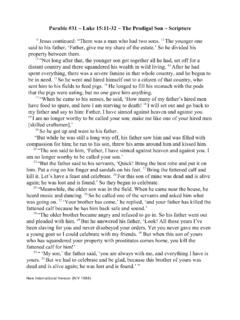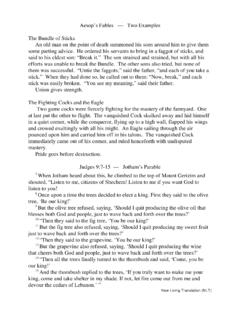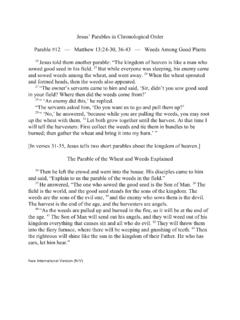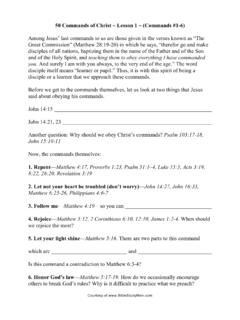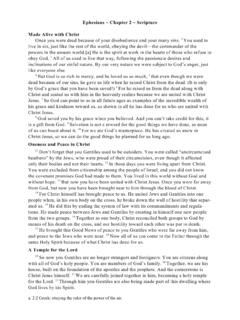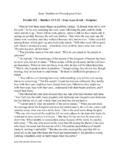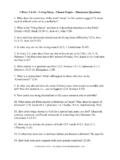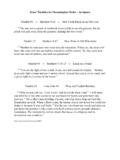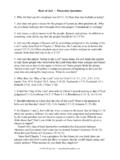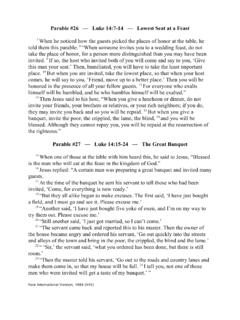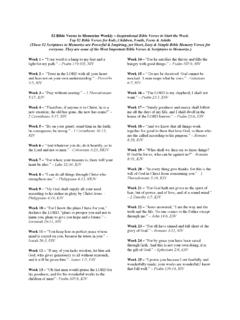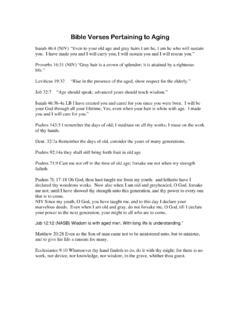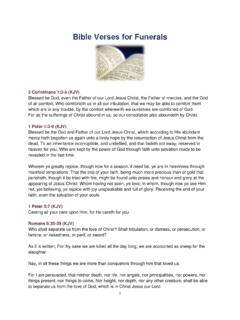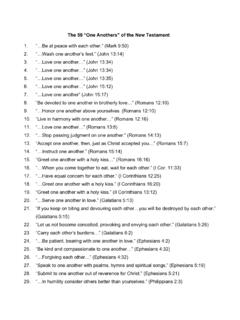Transcription of Mark 11:20-33 ~ Scripture Verses - SwapMeetDave
1 Mark 11:20-33 ~ Scripture VersesThe Withered Fig TreeThe next day as they were leaving Bethany, Jesus was hungry. Seeing in the12 13 distance a fig tree in leaf, he went to find out if it had any fruit. When he reachedit, he found nothing but leaves, because it was not the season for figs.
2 Then he14 said to the tree, May no one ever eat fruit from you again. And his disciplesheard him say it.[ Verses 15 to 19: Jesus clears the temple]In the morning, as they went along, they saw the fig tree withered from the20 roots. Peter remembered and said to Jesus, Rabbi, look! The fig tree you cursed21 has withered! Have [a] faith in God, Jesus answered. I tell you the truth, if anyone says22 23 to this mountain, Go, throw yourself into the sea, and does not doubt in his heartbut believes that what he says will happen, it will be done for him.
3 Therefore I24 tell you, whatever you ask for in prayer, believe that you have received it, and itwill be yours. And when you stand praying, if you hold anything against anyone,25 forgive him, so that your Father in heaven may forgive you your sins.[b] The Authority of Jesus QuestionedThey arrived again in Jerusalem, and while Jesus was walking in the temple27 courts, the chief priests, the teachers of the law and the elders came to him. By28 what authority are you doing these things? they asked. And who gave youauthority to do this? Jesus replied, I will ask you one question. Answer me, and I will tell you by29 what authority I am doing these things.
4 John s baptism was it from heaven, or30 from men? Tell me! They discussed it among themselves and said, If we say, From heaven, he31 will ask, Then why didn t you believe him? But if we say, From men .. 32 (They feared the people, for everyone held that John really was a prophet.)So they answered Jesus, We don t know. 33 Jesus said, Neither will I tell you by what authority I am doing these things. Footnotes:a. mark 11 :22 Some early manuscripts: If you haveb. mark 11 :25 Some manuscripts do not include mark 11 :26 But if you do notforgive, neither will your Father who is in heaven forgive your sins.[New International Version, NIV, 1984]Mark 11:20-33 ~ Discussion Questions1.
5 Why did the fig tree have no fruit? What did Jesus say to it? What happened tothe tree? (11:12-14, 11:20)2. How did this event differ from every other miracle Jesus performed?3. Why do you think that Jesus cursed the fig tree? Is there a connection betweencursing the fig tree and clearing the temple grounds? 4. The fig tree had leaves but no fruit. Is there an area of your life that looks goodbut is not producing the fruit that God wants? What is it?5. Jesus used the withered fig tree to illustrate two important truths about are they? (11:22-25)6. Why is it necessary for us to forgive others for what they have done? Why is itdifficult to forgive others?
6 What will happen (or not happen) if you don t forgiveothers? (11:25; some translations add 11:26)7. In the temple courts, who confronted Jesus? What were these things to whichthe religious leaders referred? (11:27-28)8. How did Jesus answer the challenge put to him? What condition did Jesus placeon answering the challenge? Why do you think he decided not to answer themdirectly, but instead posed a question in response? (11:29-30)9. Why was Jesus question so difficult for the religious leaders to answer? (11:31-32)10. In what ways today do human authorities challenge God s authority? Whenhave you questioned or challenged God s authority in your life?
7 11. How can we ensure that we follow God s authority rather than the authorities who challenge his word?12. When is it most difficult to submit to God s authority? Is it easier to say you llsubmit (or you want to submit) to God than to actually do it?13. With respected teachers, managers, and leaders telling you to depend upon noone but yourself, how can you find it in yourself to rely on no one except God? David H. Ahl, 2011 ~ 11:20-33 ~ Leader s Guide1. Why did the fig tree have no fruit? What did Jesus say to it? What happened tothe tree? (11:12-14, 11:20)Adapted from the Oxford Bible Commentary, we read, The two incidentswhich now follow, the cleansing of the temple and the cursing of the fig-tree,constitute the most famous example of Mark s sandwiching technique: the storyof the incident in the temple is sandwiched between the two halves of the story ofthe fig-tree.
8 By this device, Mark clearly wants the one story to interpret the for Mark the fig tree incident provides the interpretation for the templeaccount. Thus, Jesus action in the temple is probably not a cleansing (as it istraditionally described), but a cursing, a final and definitive act of judgementagainst the temple and, perhaps, fig-tree incident has always raised questions. Jesus action seems highlyarbitrary, and a pointless act of gratuitous destruction. It is compounded by thefact that the tree has leaves earlier than it should, but has no figs, which is notunreasonable as it is not yet the season for figs. Given all these problems, it is veryhard to trace any such incident back to Jesus own ministry.
9 Probably we havehere a symbolic narrative, acting as some kind of acted parable, the historical rootsof which are lost completely. What lies behind it may be passages in the OT which speak of God looking forfigs from his fig-tree, a metaphor used to refer to Israel and her proper response toGod (cf Jer 8:13); also the image of the fig-tree in fruit is used to represent Israelin the messianic age. The fruitless tree thus represents Israel who should havewelcomed her Messiah, Jesus; yet when Jesus comes to the heart of Israel,Jerusalem and the temple, he is rejected, and the tree has no fruit: the result isinevitably How did this event differ from every other miracle Jesus performed?
10 All of his other 36 miracles could be interpreted and generally understood bythose around him as being beneficial and done out of compassion: healing,restoring sight, speech and hearing, bringing a person back to life, exorcizingdemons, providing food and wine, calming the sea, causing a coin to be in a fish smouth, and walking on water. This clearly was not beneficial or compassionate,and it required an explanation from Jesus as to why he did it; an explanation thatactually seems to have little to do with the miracle Why do you think that Jesus cursed the fig tree? Is there a connection betweencursing the fig tree and clearing the temple grounds?
